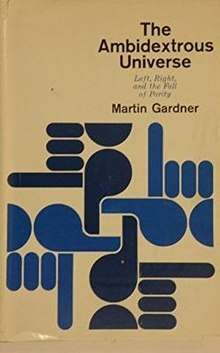The Ambidextrous Universe
The Ambidextrous Universe is a popular science book by Martin Gardner, covering aspects of symmetry and asymmetry in human culture, science and the wider universe.
 Cover of the first edition | |
| Author | Martin Gardner |
|---|---|
| Illustrator | John Mackey |
| Cover artist | Germano Facetti |
| Country | United States |
| Language | English |
| Subjects | Symmetry, Science, Mathematics |
| Publisher | Penguin Books |
Publication date | 1964 |
| Media type | Print (Paperback) |
| Pages | 276 (1st edition) 401 (3rd edition) |
| ISBN | 978-0-486-44244-0 |
| OCLC | 57373717 |
| 539.7/2 22 | |
| LC Class | QC793.3.S9 G37 2005 |
Originally published in 1964, it underwent revisions in 1969, 1979, 1990 and 2005 (the last two are known as the "Third, revised edition"). Originally titled The Ambidextrous Universe: Mirror Asymmetry and Time-Reversed Worlds, subsequent editions are known as The New Ambidextrous Universe: Symmetry and Asymmetry from Mirror Reflections to Superstrings.
Content
The book begins with the subject of mirror reflection, and from there passes through symmetry in geometry, poetry, art, music, galaxies, suns, planets and living organisms. It then moves down into the molecular scale and looks at how symmetry and asymmetry have evolved from the beginning of life on Earth. There is a chapter on carbon and its versatility and on chirality in biochemistry. Chapter 18 (and subsequent chapters) deals with a conundrum called the Ozma Problem (see below). The second half of the book concerns various aspects of atomic and subatomic physics and how they relate to mirror asymmetry and the related concepts of chirality, antimatter, magnetic and electrical polarity, parity, charge and spin. Time invariance (and reversal) is discussed. Implications for particle physics, theoretical physics and cosmology are covered and brought up to date (in later editions of the book) with regard to GUTs, TOEs, superstring theory and M-theory.
The Ozma Problem
The 18th chapter, "The Ozma Problem", poses a problem that Gardner claims would arise if Earth should ever enter into communication with life on another planet through Project Ozma. This is the problem of how to communicate the meaning of left and right, where the two communicants are conditionally not allowed to view any one object in common. The problem was first implied in Immanuel Kant's discussion of left and right, and William James mentioned it in his chapter on "The Perception of Space" in The Principles of Psychology (1890). It is also mentioned by Charles Howard Hinton. Gardner follows the thread of several false leads on the road to the solution of the Ozma Problem, in each case presenting an apparent solution which, on closer examination, turns out to be a false one.
The solution to the Ozma Problem was finally embodied in the famous "Wu experiment", conducted in 1956 by Chinese-American physicist Chien-Shiung Wu (1912–1997), involving the beta decay of cobalt-60. This experiment was the first to disprove the conservation of parity. At long last, according to Gardner, it is believed that one could carefully describe the Wu experiment to a distant extraterrestrial intelligence and thereby convey the exact meaning of left/right.
Literary references
W. H. Auden
W. H. Auden alludes to The Ambidextrous Universe in his poem "Josef Weinheber" (1965).
Vladimir Nabokov
- Pale Fire
In the original 1964 edition of The Ambidextrous Universe, Gardner quoted two lines of poetry from Vladimir Nabokov's 1962 novel Pale Fire which are supposed to have been written by a poet, "John Shade", who is actually fictional. As a joke, Gardner credited the lines only to Shade and put Shade's name in the index as if he were a real person. In his 1969 novel Ada or Ardor: A Family Chronicle, Nabokov returned the favor by having the character Van Veen "quote" the Gardner book along with the two lines of verse:
"Space is a swarming in the eyes, and Time a singing in the ears," says John Shade, a modern poet, as quoted by an invented philosopher ("Martin Gardiner" [sic]) in The Ambidextrous Universe, page 165 [sic].[1]
- Look at the Harlequins!
Nabokov's 1974 novel Look at the Harlequins!, about a man who can't distinguish left from right, was heavily influenced by his reading of The Ambidextrous Universe.[2][3]
References
- Nabokov, Vladimir (1969), Ada or Ardor: A Family Chronicle, McGraw-Hill Book Company, pg 577.
- Johnson, D. Barton (1984), "The Ambidextrous Universe of Nabakov's Look at the Harlequins!"; In: Roth, Phyllis (ed.), Critical Essays on Vladimir Nabokov; G. K. Hall.
- Hayles, N. Katherine (1984), "Ambivalence: Symmetry, Asymmetry, and the Physics of Time Reversal in Nabokov's Ada", in the same author's The Cosmic Web: Scientific Field Models and Literary Strategies in the Twentieth Century, Cornell University Press.